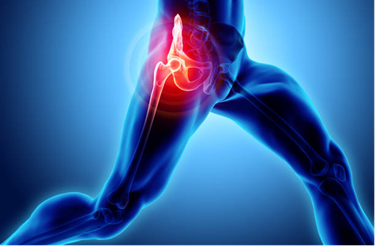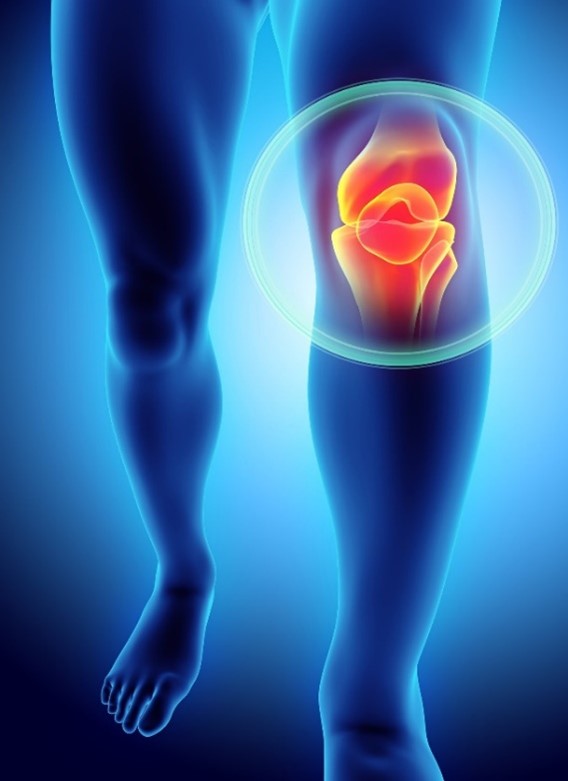Office of Research & Development |
 |
 Osteoarthritis (OA) is characterized by damage to cartilage that accumulates with time. While cartilage may function well throughout a lifetime of use, damage from aging, disease, overuse or trauma, is very common and can lead to development of OA. Indeed, the societal significance of OA is staggering. A 2012 publication from the US Bone and Joint Initiative reported that 1/5 of Americans had diagnosed arthritis and that 1/9 (equating to 21 million individuals) had some form of activity limitation because of their OA condition.
Osteoarthritis (OA) is characterized by damage to cartilage that accumulates with time. While cartilage may function well throughout a lifetime of use, damage from aging, disease, overuse or trauma, is very common and can lead to development of OA. Indeed, the societal significance of OA is staggering. A 2012 publication from the US Bone and Joint Initiative reported that 1/5 of Americans had diagnosed arthritis and that 1/9 (equating to 21 million individuals) had some form of activity limitation because of their OA condition.
 In active-duty US Service Members, more than 10,000 cases of OA are diagnosed each year. Compared to the general population, Veterans have a >10% higher incidence of doctor-diagnosed arthritis, with more than one out of every three Veterans diagnosed with and/or disabled by OA. The prevalence of post-traumatic osteoarthritis (PTOA) in our Veterans is also more than twice that of the civilian population, with 92% of these cases directly attributable to service-related injuries. A recent Arthritis Foundation report noted that service members over 40 years of age were twice as likely to develop OA after returning to civilian life compared to their age matched civilian cohort. To appreciate the significance of this issue in the Veteran population, we projected data from the Veteran Population Projection Model (VetPop2016) onto incidence rates of knee OA in the non-obese general population. Based on this, we can estimate that the total number of Veterans with symptomatic knee OA is >1.5 million. This is a conservative estimate, given that Veterans have a higher incidence of OA than non-Veterans and have more than double the incidence rate in the 35-39 year age bracket.
In active-duty US Service Members, more than 10,000 cases of OA are diagnosed each year. Compared to the general population, Veterans have a >10% higher incidence of doctor-diagnosed arthritis, with more than one out of every three Veterans diagnosed with and/or disabled by OA. The prevalence of post-traumatic osteoarthritis (PTOA) in our Veterans is also more than twice that of the civilian population, with 92% of these cases directly attributable to service-related injuries. A recent Arthritis Foundation report noted that service members over 40 years of age were twice as likely to develop OA after returning to civilian life compared to their age matched civilian cohort. To appreciate the significance of this issue in the Veteran population, we projected data from the Veteran Population Projection Model (VetPop2016) onto incidence rates of knee OA in the non-obese general population. Based on this, we can estimate that the total number of Veterans with symptomatic knee OA is >1.5 million. This is a conservative estimate, given that Veterans have a higher incidence of OA than non-Veterans and have more than double the incidence rate in the 35-39 year age bracket.
The risk of OA increases with age. Other important risk factors for OA include prior injury to the joint, joint overuse (such as occurs in center occupations like heavy construction and military careers), obesity, and having a family history of OA. Common symptoms of OA include joint pain and stiffness, joint clicking and creaking upon movement (termed “crepitus”), and occasional joint swelling. OA typically affects the large weight-bearing joints (most commonly knees and hips), the joints of the spine and the joints of the hand. Injury to other joints can lead to development of OA in non-typical joints many years after the injury. Patients with OA may start to avoid recreational activities early in the course of disease (i.e. sport-related activities, exercise) but as disease progresses they may start to find work-related activities and even basic daily activities (walking, climbing stairs, bending and kneeling, bathing and dressing) difficult. In addition, when OA affects the knee, it can lead to a feeling that the knee will “give way” (joint instability), and this can increase the risk of falls in older individuals.
 Most patients presenting with OA are treated with palliative care, including NSAIDs, pain relievers, and cortisone or hyaluronic acid injections. However, none of these interventions are disease modifying, and their efficacy ultimately decreases as OA worsens. Current clinical management of OA in the younger population seeks to delay the inevitable, until such time as a patient is sufficiently aged to be a good candidate for joint replacement surgery. But joint replacement may not be a good option for ALL individuals with OA, due to the impact of other age-related diseases on outcomes and risk, or personal choice. The dearth of treatment options compromises quality of life and increases the likelihood for opioid use, adversely impacting the health and wellbeing of our Veterans.
Most patients presenting with OA are treated with palliative care, including NSAIDs, pain relievers, and cortisone or hyaluronic acid injections. However, none of these interventions are disease modifying, and their efficacy ultimately decreases as OA worsens. Current clinical management of OA in the younger population seeks to delay the inevitable, until such time as a patient is sufficiently aged to be a good candidate for joint replacement surgery. But joint replacement may not be a good option for ALL individuals with OA, due to the impact of other age-related diseases on outcomes and risk, or personal choice. The dearth of treatment options compromises quality of life and increases the likelihood for opioid use, adversely impacting the health and wellbeing of our Veterans.
The CReATE Motion Center, with its Cores, Research Focus Areas, Training Program, Outreach, and Pilot Funding, is designed to produce new knowledge, novel products, and advances in clinical care, with the goal of restoring joint function in our Veterans.
We have already established strong and interactive relationships within the CMCVAMC and AVAMC clinical services (via our multi-disciplinary Osteoarthritis Center) and will greatly expand these programs with CReATE Motion to rapidly integrate new therapies and technology into clinical practice. We will disseminate our knowledge across the VA Center Consortium, and the broader research and clinical practices of the VA and will become a national and international leader in the field. If successful, our goal oriented CReATE Motion Center will accelerate the clinical implementation of cutting-edge strategies to restore joint function and transform the long-term health of our Veterans.
Please email Createmotion@va.gov to inquire about our Veteran advisory board or active clinical studies that are recruiting participants.